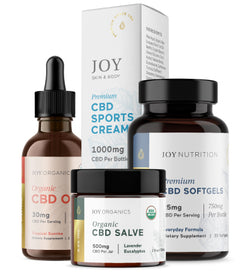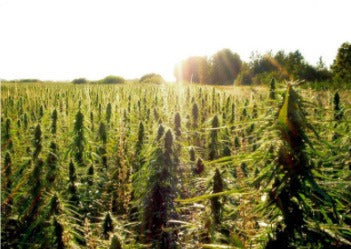
Navigating the ever-evolving world of cannabis plants can be confusing, especially when you are new to using them. After all, they're all derived from Cannabis sativa. However, not all plants are the same. There are key differences between marijuana and hemp, not only in effects and potential health benefits but also in the eyes of federal law. So, it's imperative that you know if you're holding CBD nugs vs. THC nugs. Not sure of the difference between THC and CBD flower? Let’s break down what makes hemp plants and marijuana plants so unique.
Short Summary
- Both hemp and marijuana flowers look similar, but these plants have different cannabinoid content—specifically CBD and THC
- CBD from hemp plants offers potential wellness benefits without producing intoxicating effects, while THC from marijuana plants promotes mind-altering euphoric effects
- Knowing your goals and local cannabis laws is key when deciding between CBD or THC flower for consumption.
Understanding the THC Marijuana Cannabis Plant
THC flower is also known as marijuana (or weed). A marijuana plant produces a high concentration of THC, the primary mind-altering cannabinoid in cannabis. Weed is known for its psychoactive effects, giving you a euphoric high that can also boost creativity.
Other potential wellness benefits of marijuana include supporting appetite, a good mood, and healthy sleep patterns. But, like any experience, there can be some downsides.
Consuming too much marijuana or flowers with high THC content can also lead to temporary paranoia and memory impairment. It could also start to have reverse effects on your sleep.
However, not all THC flower experiences are the same. The effects can vary depending on the strain of the cannabis flower.
Some strains will boost your creativity, while others might leave you feeling sluggish. A strain like Gorilla Glue, for instance, is famous for its chill effects, making it a favorite for unwinding after a long day.
While THC flower may have a legion of loyal fans, its legality is a different story. This cannabinoid is infamous among cannabis plants; THC made cannabis illegal in the United States for almost a century.
Although many states are adopting recreational and medical marijuana programs, weed is still federally illegal.
In contrast, CBD flower is allowed to be sold. Thanks to the 2018 Farm Bill, CBD products containing no more than 0.3% THC became allowed across the United States, and hemp was no longer considered a controlled substance.
Understanding the CBD Hemp Plant
Now that we’ve navigated the THC landscape let’s venture into the world of CBD flower. Much like marijuana yields high levels of THC, hemp produces a high CBD concentration.
However, the effects of CBD vs. THC are nothing alike. CBD hemp flower is the non-intoxicating cousin of marijuana. It’s all about delivering wellness benefits without that intoxicating high.
Derived from hemp plants, people often turn to CBD to support their overall wellness. Most commonly, people use CBD oil to support their mood, promote muscle health, and help with healthy sleep patterns. However, inhaling CBD flower can provide many of the same potential wellness benefits as CBD oil.
When it comes to the legal jousting arena, CBD flower enjoys a more favorable position. As long as the THC content of the cannabis is below the 0.3% threshold, CBD flower is allowed under the 2018 Farm Bill.
However, if a cannabis flower strays above this legal limit, it’s considered marijuana. So, while CBD flower can offer a world of benefits, it’s critical to ensure that your flower of choice meets legal requirements.
Comparing CBD Hemp Flower vs. THC Marijuana Flower
Now that we’ve explored both types of cannabis flowers individually, let’s put them side by side. On the surface, both marijuana and hemp flowers look and smell pretty much the same.
Hemp and marijuana bear the classic cannabis aroma and appearance. They both produce green buds rich in colorful hairs that contain cannabinoids and plant oils.
As we’ve learned, it’s what’s on the inside that sets a marijuana plant apart from a hemp plant. Let's take a closer look!
Appearance and Aroma
When it comes to appearance and aroma, hemp and marijuana can fool even the keenest of noses and eyes. They both hail from Cannabis sativa—sharing similar terpene profiles, phytonutrients, and cannabinoids.
As a result, hemp and marijuana look and smell alike. These similarities continue when hemp flowers and marijuana flowers are smoked.
A person consuming CBD flower legal in America may be mistaken for consuming federally illegal marijuana.
While the aromas of CBD flower and marijuana are alike, they look different up close. When comparing CBD nugs vs THC nugs, THC buds often have more complex crystal formations. These indicate a higher concentration of cannabinoids.
However, without proper testing, it can be challenging to tell the two apart based on appearance and aroma. Always read lab reports to verify cannabinoid concentrations.
Cannabinoid Content
Both hemp and marijuana have the same spectrum of cannabinoids. It's the concentration of CBD vs. THC that determines whether the flowers of a plant are hemp or marijuana.
As we've discussed, the hemp plant has only trace amounts of THC and a high CBD concentration. Besides CBD, hemp tends to have high levels of Cannabigerol (CBG), Cannabichromene (CBC), and Cannabinol (CBN).
As the minor cannabinoid industry continues to grow, so does the cultivation of flowers that produce high levels of them.
Hemp is typically bred for its fiber or seed oil, with less emphasis on maximizing cannabinoid concentration. If a hemp plant is bred for cannabinoids, it's typically to produce CBD oil.
Therefore, marijuana is the preferred plant over hemp for producing minor cannabinoids. In fact, some marijuana strains are bred to market their high minor cannabinoid content.
Strains of weed with high levels of minor cannabinoids common in hemp include:
- CBC—Bubba Cookies, Jack Herer, Purple Cadillac
- CBG—White CBG, Jack Frost CBG, Super Glue CBG
There are other cannabinoids that are more common in the marijuana plant than the CBD hemp flower. Mature plants yield high CBG levels, as that's what THC converts to with time.
Tetrahydrocannabivarin (THCV) is another compound more common in marijuana than in hemp flower. Experts predict that selective breeding of various indica and sativa strains has inadvertently increased THCV levels in some plants.
Additionally, specific strains of cannabis are known to have higher levels of THCV. This is more common in strains with African origins.
Overall Effects
CBD flower is non-intoxicating. It typically doesn't produce the "high" associated with THC flower.
Instead, CBD is often celebrated for its potential wellness benefits, such as supporting healthy sleep patterns, contributing to a calm mind, and promoting relaxed muscles.
This difference is because hemp flower has low levels of THC—the primary psychoactive compound in cannabis flower.
Consuming THC produces the “high” sensation associated with smoking weed. For many, THC flower may support euphoric feelings, alter sensory perception, and enhance focus.
However, other users may be less tolerant of THC in weed and its potent psychoactive effects. For some, THC may promote temporary paranoia, red eyes, and dry mouth.
While both CBD flower and THC flower have potential benefits, they interact differently with the body's endocannabinoid system. This key difference leads to distinct experiences.
How Flower from CBD Plants Work vs. Flower from THC Plants
Our bodies have a system called the endocannabinoid system. It's a communication network that sends messages between your brain and body so your system stays balanced.
This system has two types of "message receivers," called CB1 and CB2 receptors. CB1 receptors are mostly in the central nervous system. CB2 receptors are mostly in other parts of the body. They're most commonly found within our immune and digestive systems.
Remember, THC in cannabis is often associated with cerebral effects. That's because THC mainly binds to CB1 receptors in the brain.
This interaction changes the messages being sent to the brain, which can alter how we perceive things, our overall mood, and our behavior.
Like THC, CBD is also in cannabis. However, CBD doesn't directly talk to CB1 or CB2 receptors as much as THC. Instead, CBD helps the body's own signals (endocannabinoids) so they can have a greater effect.
Our body's natural endocannabinoids work to promote balance within the body. Cannabis compounds, like CBD, help nurture that balance.
So, even though both compounds come from the same plant and work with the same bodily systems, they do it in unique ways and cause different effects.
Vaping and Smoking Hemp Flower vs. Marijuana
Vaping or smoking flower is the fastest way to feel its effects. Whether it's THC or CBD flower, the plant's compounds are absorbed directly into your system.
These quick-acting effects make inhaling cannabis more effective compared to other THC or CBD products, like topicals and edibles.
Topicals must be absorbed through the skin. Meanwhile, edible products get absorbed through the digestive system.
These processes take longer to kick in than consuming flower. When you inhale flower from marijuana, it can cause an almost instantaneous high.
Most users report a sense of euphoria and a good mood. Other users, such as those with a low tolerance, may experience a faster heart rate and temporary paranoia.
Likewise, those who vape or smoke CBD report feeling the effects quickly. The only difference is that consuming CBD flowers isn't intoxicating.
Instead, vaping or smoking CBD could aid with occasional stress in social settings, support joint health, or help promote restful sleep.
Taking Edibles and Tinctures
Flower that is rich in CBD or THC can be used to produce oils and butter. These become the main ingredients for edible THC and CBD products.
Tinctures can be added to edibles or on their own. The major difference is the onset time of effects.
Taking CBD or THC oil by mouth via tincture drops can provide quick-acting effects. Much like inhaling flower, tincture drops bypass the digestive system for quick absorption.
Adding a tincture drop to an edible can delay effects. The difference here is that eating cannabinoids slows down the absorption process.
You must digest the food particles before you can absorb the cannabinoids and feel their effects. However, they are longer-lasting.
Instead of tinctures, flower from hemp or marijuana can also be decarboxylated, infused in butter, and strained to make everything from gummies to brownies.
What to Consider when Choosing CBD Flower vs. THC Flower
Whether you’re seeking the euphoric high of THC or the calming effects of CBD, understanding the differences between marijuana flower and hemp flower can help you make an informed decision.
For those looking for a psychoactive experience, THC flower is the way to go. If you’re seeking potential wellness benefits without intoxication, CBD hemp flower is a safer bet.
Remember, CBD flower is not restricted. Smoking CBD flower is allowed in the United States, tough state and local laws may vary.
THC flower isn’t universally accepted as hemp. Rules can vary based on location and job settings.
Lastly, a CBD product marketed as being derived from hemp flowers could still have a concentration higher than 0.3% THC.
Do your research. Read lab reports before buying flowers derived from any type of Cannabis sativa plant.
Which Cannabis Flowers Are Right for You?
The choice between CBD and THC flowers boils down to personal preference, desired effects, and legal considerations. Both offer unique experiences.
While marijuana and hemp flower are both Cannabis sativa, there is a huge difference between the two when it comes to effects and legal status. Consider your personal goals and be aware of the legality of these flowers before making your choice.
Hannah Smith is Joy Organics Director of Communications. She is driven by her passion for providing clear and accessible wellness and CBD education. In 2015, she received her BA in Media, Culture and the Arts from The King’s College in New York City and before Joy Organics, worked as writer and photographer in the Middle East and North Africa. Her work has been featured on Forbes, Vice, Vox, Denver Post, and the Coloradoan.








